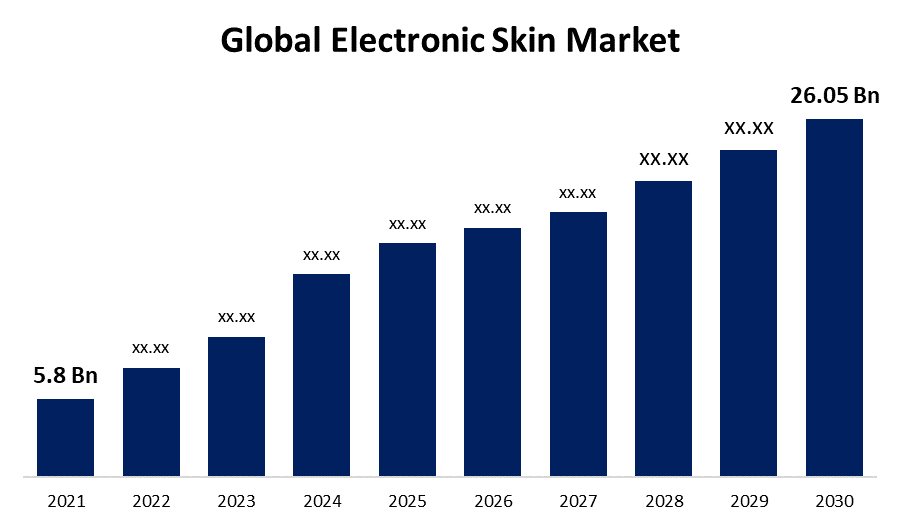Global Electronic Skin Market Size, Share, and COVID-19 Impact Analysis, By Product Type (Electronic Skinsuit, Electronic Patches), By Component (Stretchable Circuits, Stretchable Conductors, Photovoltaics System, Electroactive Polymers, Others), By Sensors Type (Electro Physiological Sensors, Tactile Sensors, Chemical Sensors, Others), By Application (Health Monitoring Systems, Cosmetics, Drug Delivery Systems, Others) and By Region (North America, Europe, Asia-Pacific, Latin America, Middle East, and Africa), Analysis and Forecast 2021 - 2030
Industry: Semiconductors & ElectronicsGlobal Electronic Skin Market Insights Forecasts to 2030
- The Global Electronic Skin Market Size was valued at USD 5.8 Billion in 2021
- The Worldwide Market Share is Growing at a CAGR of 19.5% from 2022 to 2030
- The Worldwide Electronic Skin Market Size is expected to reach USD 26.05 Billion by 2030
- Asia Pacific is expected to Grow the fastest during the forecast period

Get more details on this report -
The Global Electronic Skin Market Size is expected to reach USD 26.05 Billion by 2030, at a CAGR of 19.55% during the forecast period 2021 to 2030.
Market Overview
Electronic skin or E-skin has evolved into an integrated platform for ultra-thin, flexible, elastic, self-healing, and wearable technology that integrate telecommunications and information technology with high-performance materials, nanotechnology, and sensor systems that replicate the functionalities of either human or animal complexion. Electronic skin's capacity to tolerate mechanical stress, such as stretching and flexing, without compromising functionality is critical to various applications also including prosthetic devices, artificial intelligence, soft robotics, health monitoring, biocompatibility, and telecommunications equipment. The emergence of electronic skin, spurred by the aging population and persons who have long-lasting conditions, is predicted to benefit health care in particular. In addition, to alleviate the pain of wearing heavy external monitoring devices, flexible screens can be laminated onto the electronic skin. Electronic skin's self-healing characteristics are essential to prospective applications in industries such as soft robotics or medical implants. Electronic skin that may self-heal or be mended is typically constructed of a hybrid or polymer-based material.
Report Coverage
This research report categorizes the market for Global Electronic Skin Market based on various segments and regions and forecasts revenue growth and analyzes trends in each submarket. The report analyses the key growth drivers, opportunities, and challenges influencing the Global Electronic Skin Market. Recent market developments and competitive strategies such as expansion, product launch, and development, partnership, merger, and acquisition have been included to draw the competitive landscape in the market. The report strategically identifies and profiles the key market players and analyses their core competencies in each sub-segments of the Global Electronic Skin Market.
Global Electronic Skin Market Report Coverage
| Report Coverage | Details |
|---|---|
| Base Year: | 2021 |
| Market Size in 2021: | USD 5.8 Billion |
| Forecast Period: | 2021-2030 |
| Forecast Period CAGR 2021-2030 : | 19.5% |
| 2030 Value Projection: | USD 26.05 Billion |
| Historical Data for: | 2017-2020 |
| No. of Pages: | 200 |
| Tables, Charts & Figures: | 100 |
| Segments covered: | By Product Type, By Component, By Sensors Type, By Application, By Region, COVID-19 Impact Analysis |
| Companies covered:: | Dialog Semiconductor PLC, MC10, Intelesens Ltd., VivaLNK, Xsensio, Bloomlife, Xenoma, GENTAG, Inc, Medtronic, Plc, Chrono Therapeutics Inc., Plastic Electronics GmbH, Insulet Corporation, Physical Optics Corporation, General Electric Company, ROTEX Global, LifeSignals, iRhythm Technologies, Inc., Koninklijke Philips N.V. |
| Pitfalls & Challenges: | COVID-19 Empact, Challenge, Future, Growth, & Analysis |
Get more details on this report -
Driving Factors
The rising incidence of both chronic and non-communicable illnesses like cancer, diabetes, and cardiovascular disease will increase the demand for healthcare applications. Also, the rising adoption of IoT in home healthcare systems, that utilizes remote health monitoring such as chronic diseases, with higher independence to examine their own health and wellness, is expected to boost the electronic skin market growth. Furthermore, increased awareness regarding technologies employed in momentary wearable patches is projected to accelerate electronic skin market developments.
Increasing research and advancements regarding the use of artificial skin are also boosting the market forward. For example, experts at the Korea Institute of Mechatronics and Materials in Daejeon, South Korea, successfully created an electronic skin for a prosthetic hand. It measures the direction and strength of force, pressure, or stress to assist a person in recognizing the shape and texture of an object. Additionally, the incorporation of electronic skin into robotics, microbiology, and synthetic prosthesis systems is generating new commercial opportunities.
Restraining Factors
Nevertheless, complicated designs, material decomposition, and high electronic skin production costs are likely to challenge market expansion over the projection period. Damage to electronic skin can occur as a result of stretching, twisting, and temperature variations, which are not always accessible or noticeable. It will have a detrimental effect on the performance and durability of stretchable devices.
Market Segmentation
- In 2021, the electronic skin patches segment dominated the market with the largest share over the forecast period
Based on product type, the Global Electronic Skin Market is segmented into electronic skinsuit and electronic patches. Among them, the electronic skin patches segment dominated the market with the largest share over the forecast period. Electronic skin patches are composed of multiple elements such as sensors and actuators, as well as adequate processors, communications, and power storage. The utilization of technology innovation in many applications of healthcare devices and personal care has increased the appeal of electronic skin patches. This device keeps patients out of hospitals while simultaneously allowing them to communicate with their physicians. Integrated electronic patches are utilized in diabetic self-monitoring, motion sensing, both inpatient and outpatient remote patient monitoring, and temperature perceiving.
- In 2021, the stretchable conductors segment is witnessing significant CAGR growth over the forecast period
On the basis of component, the Global Electronic Skin Market is segmented into stretchable circuits, stretchable conductors, photovoltaics system, electroactive polymers, and others. Among these, the stretchable conductors segment is expected to grow at a significant CAGR during the forecast period owing to developments in stretchable electronic materials as well as devices that have enabled researchers to imitate the self-healing properties of human skin, accelerating the progression of skin-inspired gadgets, biomedical devices, and soft robots. Stretchable conductors have been developed as a result of the remarkable rise of nanotechnology and nanostructured materials technology. To produce high elastic properties in an electronic skin, flexible components such as Polydimethylsiloxane (PDMS), Ecoflex, and Polyurethane (PU) are generally implemented.
- In 2021, the electrophysiological sensors segment is witnessing a higher growth rate over the forecast period
Based on sensor type, the Global Electronic Skin Market is segmented into electrophysiological sensors, tactile sensors, chemical sensors, and others. Among these, the electrophysiological sensors segment witnessed a higher growth rate over the forecast period owing to the increased adoption of such sensors in healthcare applications such as chronic disease, rehabilitation treatments, and real-time patient health monitoring. Furthermore, electrophysiological sensors are extremely beneficial to the growing senior population, as they are more susceptible to diseases and require extensive medical interventions and health monitoring.
- In 2021, the health monitoring systems segment is dominating the market with the largest market share of 63% over the forecast period
Based on application, the Global Electronic Skin Market is segmented into health monitoring systems, cosmetics, drug delivery systems, and others. Among these, the health monitoring systems segment dominates the market with the largest market share of 45% over the forecast period as a result of the growing use of electronic skin devices in a variety of healthcare application fields such as neurology, cardiology, diabetes, and many others. Also, the user-friendly and wearable aspect of electronic skin enables patients to apply patches for the heart, muscles, and brain and to take tests without the assistance of a third person. Electronic skin Emerging technologies, such as electronic wearable "tattoos," can assess body temperature and stress by analyzing hydration, pulse rate, and breathing composition. The wearables use Bluetooth Low Energy or LE, or low-frequency wireless mesh to transmit patient data.
Regional Segment Analysis of the Global Electronic Skin Market
- North America (U.S., Canada, Mexico)
- Europe (Germany, France, U.K., Italy, Spain, Rest of Europe)
- Asia-Pacific (China, Japan, India, Rest of APAC)
- South America (Brazil and the Rest of South America)
- The Middle East and Africa (UAE, South Africa, Rest of MEA)
North America is dominating the market with the largest market share of 54%.

Get more details on this report -
North America is expected to remain the industry's leading region during the forecast period, with a 54% market share, due to an increasingly aging population and an increase in the number of advanced technological electronic skin product launches in the region. Increasing government attempts to lower the risk of non-communicable diseases in individuals of all ages are also driving market expansion. The region's market is also growing as a result of continuous technological improvement and enhanced medical infrastructure.
Asia Pacific is expected to grow the fastest during the forecast period, owing to ongoing high competition for an electronic skin products and services in cosmetics and medicine delivery systems. Increasing competition in the market and high investments made by the research departments and government will contribute to the growth of the electronic skin market.
Competitive Analysis:
The report offers the appropriate analysis of the key organizations/companies involved within the Global Electronic Skin Market along with a comparative evaluation primarily based on their product offering, business overviews, geographic presence, enterprise strategies, segment market share, and SWOT analysis. The report also provides an elaborative analysis focusing on the current news and developments of the companies, which includes product development, innovations, joint ventures, partnerships, mergers & acquisitions, strategic alliances, and others. This allows for the evaluation of the overall competition within the market.
List of Market Top Players
- Dialog Semiconductor PLC
- MC10
- Intelesens Ltd.
- VivaLNK
- Xsensio
- Bloomlife
- Xenoma
- GENTAG, Inc
- Medtronic, Plc
- Chrono Therapeutics Inc.
- Plastic Electronics GmbH
- Insulet Corporation
- Physical Optics Corporation
- General Electric Company
- ROTEX Global
- LifeSignals
- iRhythm Technologies, Inc.
- Koninklijke Philips N.V.
Key Target Audience
- Market Players
- Investors
- End-users
- Government Authorities
- Consulting and Research Firm
- Venture capitalists
- Value-Added Resellers (VARs)
Recent Development
- In August 2022, Xenoma has formed financial and commercial cooperation with CYBERDYNE Inc. Cooperation is expected to be a primary factor in the company's growth in the healthcare industry. With its next-generation smart garment 'e-skin,' Xenoma provides healthcare services. Xenoma will help to avoid disease by offering services and working toward the implementation of data-driven preventive medicine.
Market Segment
This study forecasts revenue at global, regional, and country levels from 2021 to 2030. Spherical Insights has segmented the Global Electronic Skin Market based on the below mentioned segments:
Global Electronic Skin Market, By Product Type
- Electronic Skinsuit
- Electronic Patches
Global Electronic Skin Market, By Component
- Stretchable Circuits
- Stretchable Conductors
- Photovoltaics Systems
- Electroactive Polymers
- Others
Global Electronic Skin Market, By Sensors Type
- Electro Physiological Sensors
- Tactile Sensors
- Chemical Sensors
- Others
Global Electronic Skin Market, By Application
- Health Monitoring Systems
- Cosmetics
- Drug Delivery Systems
- Others
Global Electronic Skin Market, Regional Analysis
- North America
- US
- Canada
- Mexico
- Europe
- Germany
- Uk
- France
- Italy
- Spain
- Russia
- Rest of Europe
- Asia Pacific
- China
- Japan
- India
- South Korea
- Australia
- Rest of Asia Pacific
- South America
- Brazil
- Argentina
- Rest of South America
- Middle East & Africa
- UAE
- Saudi Arabia
- Qatar
- South Africa
- Rest of the Middle East & Africa
Need help to buy this report?